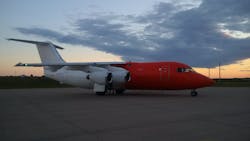35 Years After First Flight Of The BAe 146/AVRO RJ, New Operators Are Still Putting Aircraft Into Service
On September 3, 1981 the first BAe 146 regional jetliner took to the skies from the British Aerospace airfield at Hatfield, Hertfordshire. The aircraft – and its later-build successor, the Avro RJ – was destined to become Britain’s most successful jet airliner.
A total of 394 aircraft were built, with the final new-build aircraft delivered from the Woodford, Cheshire production line 22 years later in November 2003.
Today, around 220 of these aircraft remain in service in a wide variety of roles, supported fully by BAE Systems Regional Aircraft at Prestwick, Scotland – the Original Equipment Manufacturer. More than 12 million flight hours of service have been accumulated.
Acknowledging the first flight anniversary, Sean McGovern, Managing Director of BAE Systems Regional Aircraft stated today: “It is important to understand that this aircraft has many years of productive service yet to offer. In addition to supporting all our customers we work to help introduce the aircraft to new market applications through our extensive and specialist engineering capabilities. BAE Systems can provide a total support package, planned for at least a 15-20 year period.”
The aircraft still finds favour with new operators such as Pionair of Sydney, Australia, which is just starting BAe 146QT (Quiet Trader) overnight freight services on behalf of Virgin Australia which has won a 5-year U$575 million contract from TNT Express.
The newly acquired BAe 146-200QTs will fly the dedicated Eastern seaboard routes with one aircraft routing from Cairns-Brisbane-Sydney-Melbourne to Adelaide and the second in the reverse direction but with the addition of Townsville, slotted in between Brisbane and Cairns.
Steve Ferris, Chairman and Owner of Pionair adds: “Significantly, the whisperquiet BAe 146 is still the only jet airliner allowed to operate at both Sydney and Adelaide during airport curfew hours. At around 10 tonnes freight payload it is also the right size for the job. The two aircraft will fly around 2800 hours a year in total on this contract.
“In addition, we have acquired two BAe 146-200QC (Quick Change pax-to-freight variants). One of these aircraft has been converted to a full QT freight configuration for use as a maintenance spare for this contract and for ad hoc charter work. The other QC is likely to be leased out to another operator in Africa”, he said.
For freight charter work Pionair carries outsize cargo mainly for mining support work and is also looking at international markets for wet-lease services. Mr Ferris states: “The unique short-field performance, rough-field capability and large freight door makes the BAe 146 very attractive for remote operations”.
Another new niche which the BAe 146 and Avro RJ have successfully penetrated is the demanding Airtanker (aerial firefighting) role. Three operators in North America have selected the aircraft as their preferred 3000 gallon Type 1 large airtanker. The latest operator to convert an aircraft is Air Spray of Chico, California, which is in the final stages of converting the first of five BAe 146-200s and anticipating Supplemental Type Certificate (STC) approval early next year ready for the 2017 fire-fighting season.
The two other operators – Conair/Aero Flite (RJ85) and Neptune Aviation Services (BAe 146-200) each have seven aircraft in service. Both fleets have been heavily utilised throughout North America this year and Neptune reports that one of their aircraft flew 18 sorties in one very busy day.
All these airtanker operators envisage acquiring and converting additional BAe 146/Avro RJ aircraft over the next few years to meet firefighting demands and for replacement of venerable older piston and turboprop aircraft in their fleets.
As Avro RJs are starting to come out of mainline European service after many years of service with top-ranking operators such as Swiss, Brussels Airlines and CityJet, so the feedstock of aircraft available to new operators remains high.
Many of these aircraft have accumulated between 20,000-35,000 flight cycles (depending on aircraft age and history). BAE Systems offers an Avro RJ Life Extension Programme which commences at 40,000 flight cycles and clears the aircraft life limit up to 60,000 flight cycles, ensuring many years of operational service.
It is probable that potential new airline customers for the Avro RJ will take advantage of the aircraft’s low acquisition costs, proven economics, and the current low oil price to acquire these attractive aircraft for new operations in other parts of the world.
In addition, BAE Systems Regional Aircraft has just announced that it is working towards the possible launch of a passenger-to-freighter conversion programme for the Avro RJ. Building on the experience gained with the BAe 146QT, the business has spent the past 12 months (3500 man-hours) assessing the feasibility of the Avro for freighter conversion and coming up with an industrialisation plan.
The principal variant for conversion would be the RJ100 which can carry up to 14 tonnes of cargo, or with the addition of a modular underfloor fuel tank system, a smaller payload can be carried for an extra 1000 nm.
The company is currently assessing market reaction and looking for interested parties to commit to the programme for a minimum of 10 aircraft to initiate a full industrial programme.
BAE Systems will have a strategic MRO partner who will provide the freighter conversion or working party support to suit any need. The plan is to have the first conversion completed by the end of 2017.
In addition BAE Systems will work with any potential Avro RJ Freighter customers to develop bespoke modifications for the aircraft to suit differing requirements, including loadmaster seat, extended range and increased/re-distributed floor loading.
In addition to the RJ100, the RJ85 can also be developed as a freighter using the same kit. The RJ85 is cleared for unpaved runway operations, so making the aircraft very suitable for remote operations for low-density freight operations and life-line/humanitarian use.



